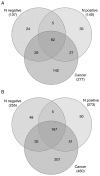Identification of potential cervical cancer serum biomarkers in Thai patients
- PMID: 32391095
- PMCID: PMC7204490
- DOI: 10.3892/ol.2020.11519
Identification of potential cervical cancer serum biomarkers in Thai patients
Abstract
Cervical cancer is one of the most common causes of cancer-associated mortality in females worldwide. Serum biomarkers are important tools for diagnosis, disease staging, monitoring treatment and detecting recurrence in different types of cancer. However, only a small number of established biomarkers have been used for clinical diagnosis of cervical cancer. Therefore, the identification of minimally invasive, sensitive and highly specific biomarkers for detection of cervical cancer may improve outcomes. In the present pilot study, changes in disease-relevant proteins in 31 patients with cervical cancer were compared with 16 healthy controls. The Human 14 Multiple Affinity Removal system was used to deplete the 14 most abundant serum proteins to decrease sample complexity and to enrich proteins that exhibited decreased levels of abundance in the serum samples. Immunoaffinity-depleted serum samples were analyzed by in-gel digestion, followed by liquid chromatography mass spectrometry analysis and data processing. Automated quantitative western blot assays and receiver operating characteristic (ROC) curves were used to evaluate the differential protein expression levels between the two groups. Capillary electrophoresis-based western blot analysis was performed to quantitatively determine serum levels of the candidate biomarkers. Significantly increased levels of α-1-antitrypsin (A1AT) and pyrroline-5-carboxylate reductase 2 (PYCR2) were detected, whereas the levels of transthyretin (TTR), apolipoprotein A-I (ApoA-I), vitamin D binding protein (VDBP) and multimerin-1 (MMRN1) were significantly decreased in patients with cervical cancer compared with the healthy controls. ROC curve analysis indicated that the sensitivity and specificity was improved through the combination of the 6 candidate biomarkers. In summary, the results demonstrated that 6 candidate biomarkers (A1AT, PYCR2, TTR, ApoA-I, VDBP and MMRN1) exhibited significantly different expression between serum samples from healthy controls and patients with cervical cancer. These proteins may represent potential biomarkers for distinguishing patients with cervical cancer from healthy controls and for differentiation of patient subgroups.
Keywords: Human 14 Multiple Affinity Removal System; apolipoprotein A-I; cervical cancer; multimerin-1; pyrroline-5-carboxylate reductase 2; serum biomarkers; transthyretin; vitamin D binding protein; α-1-antitrypsin.
Copyright: © Keeratichamroen et al.
Figures





References
-
- Oldham RK, Dillman RO, editors. Springer Science and Business Media; New York, NY: 2009. Principles of Cancer Biotherapy. - DOI
-
- Canavan TP, Doshi NR. Cervical cancer. Am Fam Physician. 2000;61:1369–1376. - PubMed
-
- Gaarenstroom K, Bonfrer J, Korse C, Kenter G, Kenemans P. Value of Cyfra 21-1, TPA, and SCC-Ag in predicting extracervical disease and prognosis in cervical cancer. Anticancer Res. 1997;17:2955–2958. - PubMed
LinkOut - more resources
Full Text Sources
Research Materials
Miscellaneous
